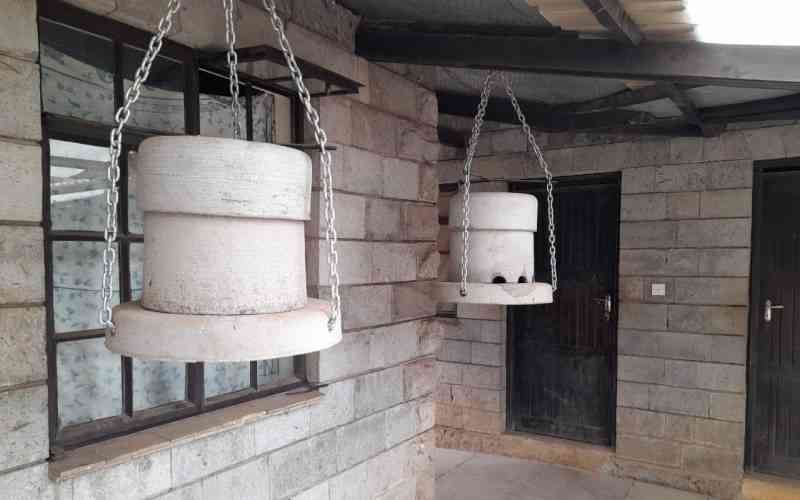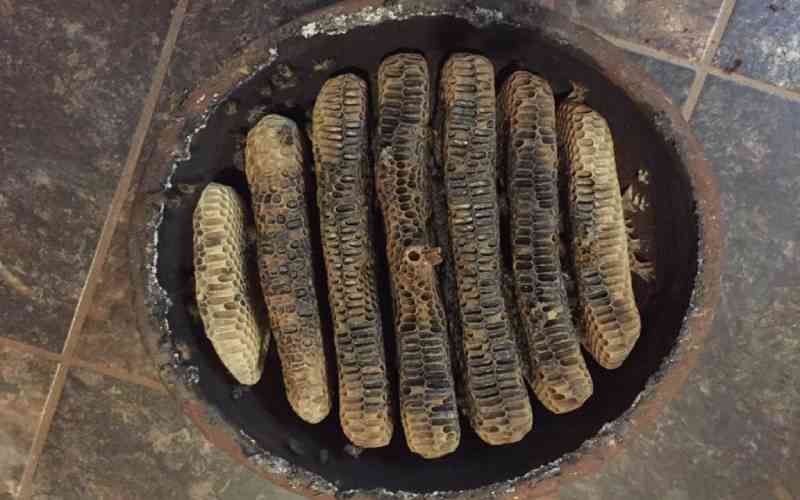
The practice of beekeeping can be a difficult task, especially considering the dire state of bee populations worldwide.
Over the past 30-plus years, pollinator populations have crashed worldwide due to a variety of reasons, including pesticide and herbicide exposure, invasive pests and diseases, loss of habitat and a changing climate, scientists say.
Bee farmers in Kenya are also feeling this effect, they are facing the same declining bee populations that are being witnessed across the globe. They are also threatened by fires, honey badgers and even thieves.
However, of late there has been an increase in modern beekeeping, this is after the national government’s strategy for development of apiculture and emerging livestock, identified honey production as an income-generating activity for people living in ASAL areas.
Ezekiel Mumo founder of Bee Farmers Hub company and also a bee farmer in Rongai, is taking a new approach to bee farming by using concrete beehives instead of the normal Langstroth, topbar or even the traditional log hives.
“I have tried it and it is better than the Langstroth, it is a new way of doing things, you will find out that you manage to save yourself some pocket change.” Says Mumo.

He started the concrete hive initiative 2 years ago during the prevalence of the Covid-19 pandemic with 3 hives for his own use as a trial, after three months of waiting, there they were, bees swarming all over the backyard.
“Beekeepers are like landlords with very flexible lease agreements. The bees only pay rent when they can afford it. They can leave if you harass them. They can leave because you take too much rent which is their honey. They will leave if they don’t feel safe, but if they like the place, they will stick around.” Says Mumo.
Let us look at the Langstroth bee hive and see some of the advantages to it as Nick Evans, a bee farmer from Hardy in Karen explains.
Langstroth Hive
Let us think of the Langstroth hive as a grocery store. The bees, in this case, are the proprietors. Now, for the grocery store to be efficient, it has put the space available to the best possible use.
If the aisles are too wide, then you lose out on shelf space and limit how much product is available to the customer.
If it’s too narrow, you’ll have to change the name of the store, because it will now become a kiosk or a squeezed shop.
So you’ll want to seal off those spaces and find an alternative use for it, such as advertising. The bees work in a very similar way.
“What makes this type of hive so effective and allows its core principles to remain in use over 100 years later is the application of bee space.” Says Evans.
If the space in their beehive is too small, they seal it off with propolis. If the space is too wide, they build more honey storage space.
Advantages of Langstroth Hive
They can be transported with ease, Langstroth are made using light material and can be easily moved from one location to the other.High honey yield. According to African bee keepers, the contemporary bee hive, a farmer can collect 20 to 30kgs per harvest as opposed to the traditional log hive that fetches 10 to 15kgs.
Easy to inspect and harvest.The interchangeable parts mean you can get supplies from multiple manufacturers.The beehive is easy to maintain. A coat of paint every few years keeps it going.
Disadvantages of Langstroth Hive
Requires a bit of heavy lifting. This hive grows vertically, so as the colony becomes established, inspecting the hive will require you to lift the upper boxes off in order to check on the brood area and see how your queen is getting on.It’s not the “natural” way. Well, this point is heavily debated. In truth, anything that isn’t the trunk of a tree isn’t particularly natural. Many argue that the use of foundation takes away the natural freedom of the bee to build the comb with cells that suit the colony.“My solution is you could do away with the foundation, and in many parts of the world, they only put wax strips as a placeholder, directing the bees to build comb from that point downward.” Says Evans.
Concrete Beehive
In recent years’ lightweight concrete has become a common building material and has opened up the possibilities for using concrete in a wide range of new fields and applications.
Ezekiel Mumo chose the concrete bee hive after a series of disappointments from using Langstroth.
“When you think about bee keeping, concrete does not come to mind, therefore I decided to look at this type of farming differently, He says.
The concrete hive has a round base and a cylindrical top (lid) where the bees make the honey in a circular manner.
“Inside the concrete hive honey bees keep the temperature inside the beehive highly regulated between 30 and 34 degrees Celsius in order to maintain the health of their brood.” He says.
However, doing so uses energy and requires that honey bees eat from their honey stores. Mumo’s beehives are made of concrete, a better insulator than wood.
“This allows for a beehive that experiences a more stable temperature throughout the day. Ultimately, the honey bees can spend less time cooling their beehive on hot days and more time foraging for honey.” Says Mumo.
Sometimes the weight of the concrete is reduced by replacing some or all of the aggregates (sand/stone) with a lighter substitute. The most common lightweight aggregates are expanded slate, shale or clay, such as Perlite and Vermiculite.
“It takes 3 months for me to harvest honey,” he says. This has increased honey in stores by about three hundred percent in the beehives he has produced.
Advantages of the concrete beehive
· The concrete hive is more durable and protected than conventional wooden beehives. “It does not rot, cannot be attacked by pests that eat the wood off.” Says Mumo.
· According to Mumo, it is affordable and easily manufactured. “You can get one at Sh5000 to Sh10,000 depending on the size.” He says.
· Molds for the beehive are available to beekeepers so that they can continue to create beehives on their own, needing only the concrete that the beehives are made of.
· Prevents thieves from stealing due to the heaviness of the hive
· Materials used are readily available. (Concrete and water)
Disadvantages of Concrete beehive
· Can break easily, especially when it is carried carelessly.
· “Does not hold a lot of bees, a single colony can have 30000 to 40000 worker bees, drones can range between 100 to 150, the queen can lay between 1000 to 1200 eggs.” Says Mumo.
· Amount of honey that is harvested is between 5 to 10kg.
· The temperatures inside the concrete can sometimes drop to a low of 15 degrees Celsius.
An apiarist and bee expert, Nickson Nyagancha says, the concrete hive is a new way of farming that can be beneficial to a bee keeper.
“Farmers are now using concrete due to its thermodynamic characteristics,” says Nyagancha.
According to Nyagancha, in a wooden hive, honey output during the hot season is low as bees spend a majority of their time flapping their wings to cool the internal temperature.
“When it’s cold, they clamp together to keep warm. But concrete as a non-heat conductor doesn’t allow heat inside or outside.” He says.
“These saved hours increase honey production by 40 percent because bees continue working at full capacity despite the weather conditions,” says Nyagancha.
As a beekeeper, you can’t control all the variables. But there’s good news. Bees can be quite adaptable. If you get most of what they want right, they’ll put up with the factors that are beyond your control.
 The Standard Group Plc is a multi-media organization with investments in media platforms spanning newspaper print
operations, television, radio broadcasting, digital and online services. The Standard Group is recognized as a
leading multi-media house in Kenya with a key influence in matters of national and international interest.
The Standard Group Plc is a multi-media organization with investments in media platforms spanning newspaper print
operations, television, radio broadcasting, digital and online services. The Standard Group is recognized as a
leading multi-media house in Kenya with a key influence in matters of national and international interest.

